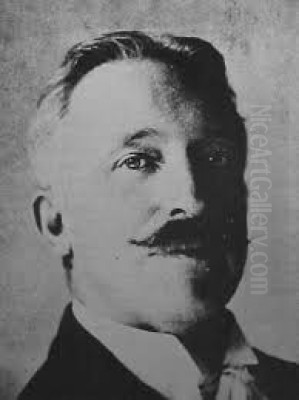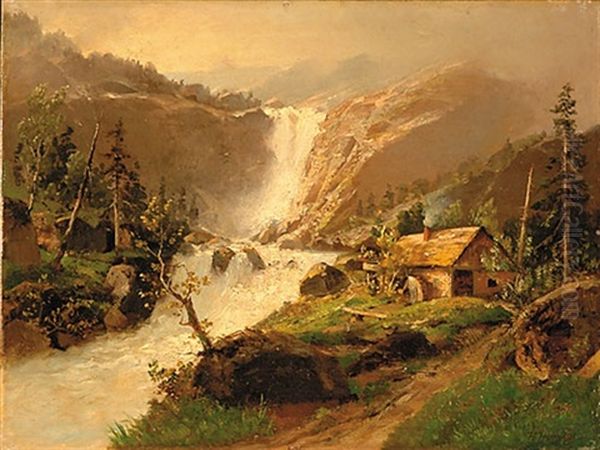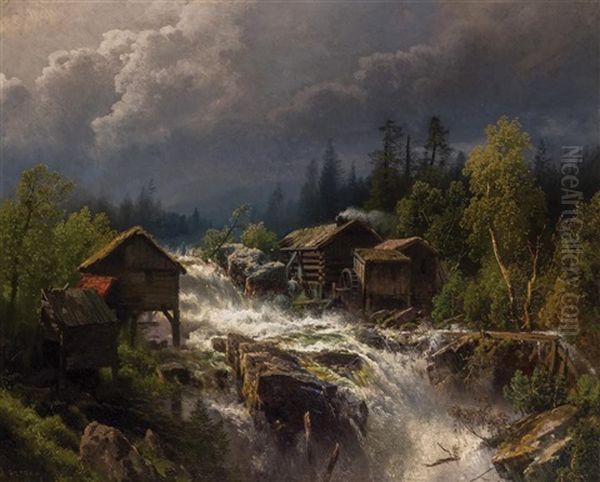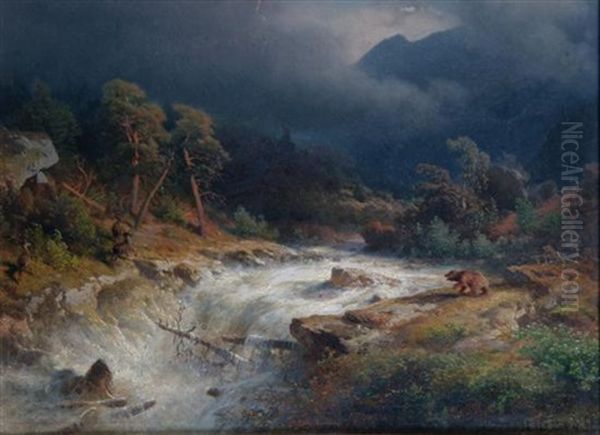Introduction

Hermann Ottmar Herzog stands as a significant figure in 19th and early 20th-century art, a painter whose life and work bridged the artistic traditions of Europe and the burgeoning landscape movement in America. Born in Germany and later becoming a citizen of the United States, Herzog dedicated his exceptionally long life (1832-1932) to capturing the beauty and power of the natural world. Primarily known as a landscape painter, his prolific output and distinctive style, rooted in the Düsseldorf School but evolving through extensive travel, have earned him a lasting place in art history. His canvases, often depicting dramatic mountain vistas, serene forest interiors, and dynamic coastal scenes, reflect a deep engagement with nature across two continents.
Early Life and Artistic Formation in Germany
Hermann Ottmar Herzog was born in the Free Hanseatic City of Bremen, Germany, on November 15, 1832. Showing artistic promise early on, he embarked on formal training at the relatively young age of sixteen or seventeen. In 1848, he enrolled in the prestigious Düsseldorf Academy (Kunstakademie Düsseldorf), one of the most influential art schools in Europe at the time. This decision placed him at the heart of a vibrant artistic center known for its rigorous training and its particular emphasis on landscape painting.
The environment at the Düsseldorf Academy was crucial in shaping Herzog's foundational skills and artistic outlook. The curriculum stressed meticulous observation, detailed rendering, and a strong grounding in drawing. Students were encouraged to study nature directly, often undertaking sketching trips to supplement their studio work. This academic training provided Herzog with the technical proficiency that would underpin his entire career, enabling him to render complex natural forms with remarkable accuracy and confidence. His time in Düsseldorf laid the groundwork for his lifelong dedication to landscape art.
The Düsseldorf Influence

During his studies at the Düsseldorf Academy, Herzog had the privilege of learning from several prominent artists who were leading figures of the Düsseldorf School of painting. Among his most significant teachers were Andreas Achenbach and the Norwegian painter Hans Gude. Andreas Achenbach, renowned for his dramatic seascapes and landscapes, instilled in Herzog a sense of dynamism and a keen eye for atmospheric effects. Achenbach was a master at capturing the raw power of nature, a quality that would resonate in Herzog's later works.
Hans Gude, specializing in majestic mountain scenery and coastal views, particularly of his native Norway, further guided Herzog's development as a landscape painter. Gude's influence likely encouraged Herzog's own interest in mountainous terrains and dramatic natural spectacles. The Düsseldorf School itself, characterized by its detailed realism often blended with Romantic sensibilities, profoundly shaped Herzog's approach. Other notable artists associated with the school during this era, whose influence permeated the Academy, included Johann Wilhelm Schirmer, a key figure in establishing landscape painting as a major genre there, Andreas Achenbach's brother Oswald Achenbach, known for his Italian scenes, and Carl Friedrich Lessing, famed for his historical and landscape works. This rich artistic milieu provided Herzog with a strong technical and stylistic foundation.
European Travels and Early Success
Herzog's artistic vision was significantly broadened by extensive travels throughout Europe. A pivotal journey occurred in 1855 when he first visited Norway. The rugged fjords, towering mountains, and dramatic light of the Scandinavian landscape made a profound impression on him, influencing his style towards capturing the sublime and powerful aspects of nature. This trip is often cited as a key moment in the development of his mature artistic voice, providing him with subjects that resonated with the Romantic spirit prevalent in landscape painting at the time.
His travels were not limited to Northern Europe. Herzog also explored other regions, including Italy, where he painted scenes such as the picturesque Lake Garda. His growing reputation led to significant recognition. He successfully submitted works to the prestigious Paris Salon, exhibiting there and receiving honorable mentions in both 1863 and 1864. Furthermore, his talent attracted the attention of European nobility and royalty. He secured patronage from figures such as Queen Victoria of Great Britain, Grand Duke Alexander II of Russia, and the Countess of Flanders, painting works for their collections. This early success in Europe established him as a respected artist before he even crossed the Atlantic.
Emigration to America

Despite his success in Europe, political changes in his homeland prompted a major life decision. Around 1869, Herzog chose to emigrate from Germany to the United States. The primary catalyst for this move was the impending incorporation of his native city, Bremen, into the Kingdom of Prussia, a political shift he reportedly wished to avoid. Seeking a new home where he could continue his artistic pursuits freely, he settled in Philadelphia, Pennsylvania.
Philadelphia, at the time, was a major cultural and artistic center in the United States, boasting institutions like the Pennsylvania Academy of the Fine Arts (PAFA), where Herzog would later exhibit. The city provided a stable base for him and his family, and it would remain his home for the rest of his exceptionally long life. This move marked the beginning of the second major phase of his career, during which he would turn his well-honed skills towards capturing the diverse and often dramatic landscapes of his adopted country. His European training provided a unique lens through which to view the American wilderness.
Exploring the American Landscape
Once settled in the United States, Hermann Herzog embarked on extensive travels, seeking out the natural wonders of the North American continent. He was particularly drawn to the dramatic scenery of the American West. Multiple trips took him to California, where he painted the iconic Yosemite Valley, the rugged Sierra Nevada mountains, and the Hetch Hetchy Valley (before it was dammed). These works captured the grandeur and unique light of the Californian landscape, contributing to the growing artistic appreciation of the region.
His explorations were not confined to the West Coast. Herzog also traveled to Florida, capturing its subtropical lushness, distinctive waterways, and atmospheric effects, as seen in works like Moonrise in Florida. His journeys also took him to Oregon and Wyoming, among other states. Throughout these travels, he applied his meticulous technique and sensitivity to atmosphere, creating a vast portfolio of American scenes. He seemed particularly fascinated by dynamic natural phenomena – waterfalls, rapids, dramatic sunsets, and storm-threatened skies feature prominently in his American oeuvre, showcasing his ability to convey the untamed spirit of the wilderness.
Artistic Style and Comparisons

Hermann Herzog's artistic style is often characterized as a blend of the detailed realism learned at the Düsseldorf Academy and a Romantic sensibility in his choice of subjects and atmospheric rendering. His paintings are noted for their technical precision, careful composition, and convincing depiction of natural textures – rock, water, foliage, and clouds. He possessed a remarkable ability to capture the effects of light and atmosphere, lending his scenes a palpable sense of place and mood, whether depicting the clear, sharp light of the Sierras or the humid haze of a Florida evening.
While active during the peak of the Hudson River School, America's preeminent landscape painting movement, Herzog's relationship to it is nuanced. His work shares similarities with leading Hudson River School artists like Albert Bierstadt (also German-born and Düsseldorf-trained) and Frederic Edwin Church, particularly in their shared interest in sublime landscapes and dramatic natural effects. However, Herzog's style is generally considered more realistic and less overtly theatrical or idealized than the works of Bierstadt or Church. While capturing nature's grandeur, Herzog often maintained a more objective, detailed approach, perhaps reflecting his rigorous German training. His work can also be seen in dialogue with other American landscape painters like Thomas Moran, known for his spectacular Western scenes, and William Trost Richards, who shared an interest in meticulous detail, especially in coastal subjects.
Key Works and Themes
Over his long career, Hermann Herzog created an estimated oeuvre exceeding one thousand paintings. While a comprehensive list is vast, certain works and recurring themes stand out. His European period is well-represented by paintings like On the Promenade of Lake Garda (1894), showcasing his ability to capture the serene beauty and specific light of an Italian landscape. His Norwegian scenes, inspired by his early travels, often depict dramatic fjords and coastal views, emphasizing the raw power of nature in the north.
In America, his paintings of Yosemite Valley are among his most celebrated works, capturing the iconic granite cliffs, waterfalls, and majestic scale of the location. Series depicting the valley from various viewpoints showcase his sustained engagement with this landscape. Similarly, his views of the Hetch Hetchy Valley provide valuable artistic records of that landscape before its transformation. Florida scenes, such as Moonrise in Florida or depictions of its rivers and swamps, highlight his versatility in capturing different climates and moods. Recurring themes throughout his work include powerful waterfalls, dense forest interiors, expansive mountain ranges, and coastal scenes, often imbued with a strong sense of atmosphere and the dynamic interplay of light and shadow. Works like Tropical Woman with Bear (mentioned in source material, though perhaps atypical) and generic titles like Waterfall Landscape point to the breadth of his subject matter within the landscape genre.
Exhibitions and Recognition in America
After immigrating, Herzog continued to exhibit his work and gain recognition within the American art scene. Even before permanently settling, he participated in the annual exhibitions at the Pennsylvania Academy of the Fine Arts (PAFA) in Philadelphia between 1863 and 1869, indicating his early connections to the American art world. His presence in Philadelphia was further solidified by his participation in the landmark Philadelphia Centennial Exhibition of 1876. This major international exposition celebrated the 100th anniversary of American independence. Herzog contributed paintings of both Norwegian scenery and views of Yosemite, earning a bronze medal for his submissions. This event provided significant exposure to a wide audience.
He also exhibited at other important venues, including the National Academy of Design in New York City in 1882. While he was known for not aggressively marketing his work during his lifetime, preferring to hold onto many of his paintings, his participation in these key exhibitions demonstrates his engagement with the professional art world in his adopted country. These activities helped establish his reputation among American collectors and fellow artists, even if widespread fame came later.
Connections with Contemporaries
Hermann Herzog's long career intersected with numerous important artists on both sides of the Atlantic. His formative years in Düsseldorf placed him in direct contact with his influential teachers, Andreas Achenbach and Hans Gude. He was also part of the broader Düsseldorf Academy milieu, which included significant figures like Johann Wilhelm Schirmer, Oswald Achenbach, and Carl Friedrich Lessing, whose work and teaching philosophy shaped the environment. The shared training ground meant he was technically and stylistically aligned with many artists emerging from Düsseldorf.
In America, his work inevitably drew comparisons with the leading figures of the Hudson River School, such as Albert Bierstadt, Frederic Edwin Church, and Thomas Moran. While perhaps not part of their immediate circle, his subject matter (especially the American West) and stylistic elements placed him in conversation with their work. He also had connections within the Philadelphia art community, associating with artists like the still-life painter George Cope. His contemporaries in the broader American art scene included figures like Winslow Homer, known for his powerful marine subjects and scenes of American life, and Thomas Eakins, Philadelphia's leading realist painter, though their primary subjects differed significantly from Herzog's landscape focus. Another relevant contemporary, particularly regarding detailed landscape and marine painting with Düsseldorf links, was William Trost Richards. These connections and comparisons help situate Herzog within the complex artistic landscape of the 19th century.
Later Life and Prolific Output
One of the most remarkable aspects of Hermann Herzog's life was his longevity and sustained artistic activity. He lived to be nearly 100 years old, passing away in Philadelphia on February 6, 1932. Unlike many artists whose output diminishes in later years, Herzog continued to paint actively well into his old age. This dedication resulted in an extraordinarily large body of work, estimated at over 1,000 paintings created throughout his career.
He reportedly invested the earnings from his early European sales wisely, which gave him considerable financial independence later in life. This independence allowed him the freedom to travel extensively and to paint according to his own artistic inclinations, rather than being solely dependent on commissions or sales. It also meant that he retained a large number of his own works throughout his lifetime. His son, Lewis Herzog, also became a painter, continuing the family's artistic inclinations. Hermann Herzog's long life spanned a period of significant change in the art world, from the height of Romanticism and Realism to the dawn of Modernism, yet he remained largely consistent in his dedication to landscape painting grounded in his Düsseldorf training.
Posthumous Rediscovery and Legacy
Although respected during his lifetime and patronized by notable figures, Hermann Herzog did not achieve the widespread fame of some of his contemporaries, partly due to his reluctance to sell many of his works. Consequently, a large portion of his oeuvre remained with his family after his death. It wasn't until the 1970s that his paintings began to enter the art market in significant numbers, leading to a posthumous rediscovery and a surge of interest among collectors and art historians.
Today, Hermann Herzog's work is held in the collections of numerous prestigious museums across the United States and Europe. In the US, these include the Metropolitan Museum of Art in New York, the Philadelphia Museum of Art, the Smithsonian American Art Museum in Washington D.C., the Fine Arts Museums of San Francisco, the Cincinnati Art Museum, the Reading Public Museum in Pennsylvania, and the Charles Hosmer Morse Museum of American Art in Winter Park, Florida, which holds a significant collection. The Brandywine River Museum of Art in Chadds Ford, Pennsylvania, further contributed to his recognition by mounting a major retrospective exhibition of his work. This institutional recognition solidifies his legacy as a skilled and important painter of both European and American landscapes.
Market Performance
Following the rediscovery of his work in the latter half of the 20th century, Hermann Herzog's paintings have found a strong and appreciative market. His technical skill, appealing subject matter, and the sheer volume of his output ensure a steady presence at auctions and galleries specializing in American and European art of the period. Auction results reflect a solid demand for his work. For instance, an unsigned painting titled Moonrise in Florida achieved a price of $32,312, noted as a record for an unsigned work by the artist at that time.
Specific sales highlight the value placed on his paintings. At one auction held by Boyd Auctions, a pair of miniature paintings by Herzog generated considerable excitement, ultimately selling for $77,000 (or $38,500 each before buyer's premium), significantly exceeding their initial estimates. This indicates strong interest from collectors across the country. While perhaps not reaching the absolute highest prices commanded by some of the biggest names of the Hudson River School, Herzog's works consistently perform well, appreciated for their quality, historical context, and aesthetic appeal. The market reflects his established position as a significant transatlantic landscape painter.
Conclusion
Hermann Ottmar Herzog's century-long life was one of remarkable artistic dedication and achievement. As a German-born artist who spent a significant portion of his career documenting the landscapes of America, he occupies a unique position in art history. Trained in the rigorous Düsseldorf tradition, he brought a European sensibility and technical mastery to his depictions of the American wilderness, while also contributing significantly to the landscape genre in Europe. His prolific output, detailed yet atmospheric style, and extensive travels resulted in a rich and diverse body of work that continues to captivate viewers today. From the fjords of Norway to the valleys of Yosemite, Herzog captured the beauty, drama, and sublime power of the natural world, leaving behind an enduring legacy that bridges continents and artistic traditions. His rediscovery in the late 20th century rightfully secured his place as a master of 19th and early 20th-century landscape painting.